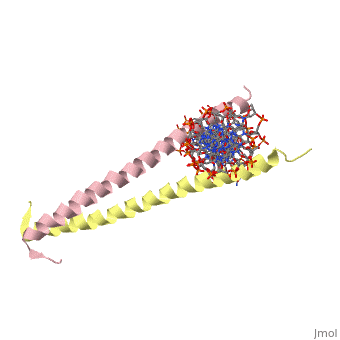Tom Sandbox: Difference between revisions
No edit summary |
No edit summary |
||
| Line 19: | Line 19: | ||
GCN4 is said to have a heptad repeat, or seven unit repeated sequence. Here the heptad repeat is a leucine, every seven units. When the structure of the alpha helices is taken into account, it is clear that each leucine is being stacked on top of the last one, every seven units. This creates the zipper-like repeated projections from the two polypeptide chains. Below we see a pictorial representation of the sequence of amino acids as we look down the length of the coiled coil structure. | GCN4 is said to have a heptad repeat, or seven unit repeated sequence. Here the heptad repeat is a leucine, every seven units. When the structure of the alpha helices is taken into account, it is clear that each leucine is being stacked on top of the last one, every seven units. This creates the zipper-like repeated projections from the two polypeptide chains. Below we see a pictorial representation of the sequence of amino acids as we look down the length of the coiled coil structure. | ||
[[Image:Coiledcoil-wheelcartoon.gif|300px]] | [[Image:Coiledcoil-wheelcartoon.gif|center|300px]] | ||
'''Image 1:A pictorial representation of the heptad repeat. By following through the wheels alphabetically, it is clear how the leucines will stack every 7 units. The apostrophe denotes the other subunit.'''(from Kgutwin in Wikipedia Commons http://commons.wikimedia.org/wiki/File:Coiledcoil-wheelcartoon.gif) | '''Image 1:A pictorial representation of the heptad repeat. By following through the wheels alphabetically, it is clear how the leucines will stack every 7 units. The apostrophe denotes the other subunit.'''(from Kgutwin in Wikipedia Commons http://commons.wikimedia.org/wiki/File:Coiledcoil-wheelcartoon.gif) | ||
At every a and a' we have a Leucine, while at the d and d' locations we typically see valine. <ref name="Voet" /> | At every a and a' we have a Leucine, while at the d and d' locations we typically see valine. <ref name="Voet" /> | ||
===Binding=== | ===Binding=== | ||
Revision as of 05:53, 9 November 2011

| |||||||
| 2zta, resolution 1.80Å () | |||||||
|---|---|---|---|---|---|---|---|
| Non-Standard Residues: | |||||||
| |||||||
| Resources: | FirstGlance, OCA, RCSB, PDBsum | ||||||
| Coordinates: | save as pdb, mmCIF, xml | ||||||
GCN4 - The Leucine ZipperGCN4 - The Leucine Zipper
Blah blah information about leucine zipper GCN4.
| |||||||||
| 1ysa, resolution 2.90Å () | |||||||||
|---|---|---|---|---|---|---|---|---|---|
| |||||||||
| |||||||||
| Resources: | FirstGlance, OCA, RCSB, PDBsum | ||||||||
| Coordinates: | save as pdb, mmCIF, xml | ||||||||
StructureStructure
GCN4 (PDB 2zta by itself, 1ysa bound to DNA) is a eukaryotic transcription factor first isolated from Saccharomyces cerevisiae, also known as Baker's Yeast. CITE CITE CITE It is composed of two identical 52 residue alpha helix chains that grouped together to form a dimer. The dimer binds through interlocking leucine amino acids in the C terminal ends, while pinching in on the major groove of DNA in the N terminal end. The X-ray structure of the 33-residue polypeptide corresponding to the leucine zipper of GCN4 was determined by Peter Kim and Thomas Alber[1].
Heptad RepeatHeptad Repeat
GCN4 is said to have a heptad repeat, or seven unit repeated sequence. Here the heptad repeat is a leucine, every seven units. When the structure of the alpha helices is taken into account, it is clear that each leucine is being stacked on top of the last one, every seven units. This creates the zipper-like repeated projections from the two polypeptide chains. Below we see a pictorial representation of the sequence of amino acids as we look down the length of the coiled coil structure.

Image 1:A pictorial representation of the heptad repeat. By following through the wheels alphabetically, it is clear how the leucines will stack every 7 units. The apostrophe denotes the other subunit.(from Kgutwin in Wikipedia Commons http://commons.wikimedia.org/wiki/File:Coiledcoil-wheelcartoon.gif)
At every a and a' we have a Leucine, while at the d and d' locations we typically see valine. [1]

